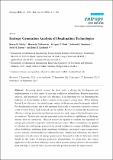| dc.contributor.author | Mistry, Karan Hemant | |
| dc.contributor.author | McGovern, Ronan Killian | |
| dc.contributor.author | Thiel, Gregory P. | |
| dc.contributor.author | Summers, Edward K. | |
| dc.contributor.author | Zubair, Syed M. | |
| dc.contributor.author | Lienhard, John H. | |
| dc.date.accessioned | 2012-02-28T14:06:31Z | |
| dc.date.available | 2012-02-28T14:06:31Z | |
| dc.date.issued | 2011-09 | |
| dc.date.submitted | 2011-09 | |
| dc.identifier.issn | 1099-4300 | |
| dc.identifier.uri | http://hdl.handle.net/1721.1/69217 | |
| dc.description.abstract | Increasing global demand for fresh water is driving the development and implementation of a wide variety of seawater desalination technologies. Entropy generation analysis, and specifically, Second Law efficiency, is an important tool for illustrating the influence of irreversibilities within a system on the required energy input. When defining Second Law efficiency, the useful exergy output of the system must be properly defined. For desalination systems, this is the minimum least work of separation required to extract a unit of water from a feed stream of a given salinity. In order to evaluate the Second Law efficiency, entropy generation mechanisms present in a wide range of desalination processes are analyzed. In particular, entropy generated in the run down to equilibrium of discharge streams must be considered. Physical models are applied to estimate the magnitude of entropy generation by component and individual processes. These formulations are applied to calculate the total entropy generation in several desalination systems including multiple effect distillation, multistage flash, membrane distillation, mechanical vapor compression, reverse osmosis, and humidification-dehumidification. Within each technology, the relative importance of each source of entropy generation is discussed in order to determine which should be the target of entropy generation minimization. As given here, the correct application of Second Law efficiency shows which systems operate closest to the reversible limit and helps to indicate which systems have the greatest potential for improvement. | en_US |
| dc.description.sponsorship | King Fahd University of Petroleum and Minerals | en_US |
| dc.description.sponsorship | Center for Clean Water and Clean Energy at MIT | en_US |
| dc.language.iso | en_US | |
| dc.publisher | MDPI Publishing | en_US |
| dc.relation.isversionof | http://dx.doi.org/10.3390/e13101829 | en_US |
| dc.rights | Creative Commons Attribution | en_US |
| dc.rights.uri | http://creativecommons.org/licenses/by/3.0/ | en_US |
| dc.source | Karan Mistry | en_US |
| dc.title | Entropy Generation Analysis of Desalination Technologies | en_US |
| dc.type | Article | en_US |
| dc.identifier.citation | Mistry, Karan H. et al. “Entropy Generation Analysis of Desalination Technologies.” Entropy 13.10 (2011): 1829-1864. © 2011 MDPI Publishing | en_US |
| dc.contributor.department | Massachusetts Institute of Technology. Department of Mechanical Engineering | en_US |
| dc.contributor.approver | Lienhard, John H. | |
| dc.contributor.mitauthor | Mistry, Karan Hemant | |
| dc.contributor.mitauthor | McGovern, Ronan Killian | |
| dc.contributor.mitauthor | Thiel, Gregory P. | |
| dc.contributor.mitauthor | Summers, Edward K. | |
| dc.contributor.mitauthor | Lienhard, John H. | |
| dc.relation.journal | Entropy | en_US |
| dc.eprint.version | Final published version | en_US |
| dc.type.uri | http://purl.org/eprint/type/JournalArticle | en_US |
| eprint.status | http://purl.org/eprint/status/PeerReviewed | en_US |
| dspace.orderedauthors | Mistry, Karan H.; McGovern, Ronan K.; Thiel, Gregory P.; Summers, Edward K.; Zubair, Syed M.; Lienhard V, John H. | en |
| dc.identifier.orcid | https://orcid.org/0000-0002-2901-0638 | |
| dc.identifier.orcid | https://orcid.org/0000-0002-3808-8824 | |
| dc.identifier.orcid | https://orcid.org/0000-0002-4583-1057 | |
| mit.license | PUBLISHER_POLICY | en_US |
| mit.metadata.status | Complete | |
